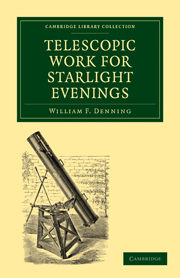Book contents
- Frontmatter
- PREFACE
- Contents
- ILLUSTRATIONS
- CHAPTER I THE TELESCOPE, ITS INVENTION AND THE DEVELOPMENT OF ITS POWERS
- CHAPTER II RELATIVE MERITS OF LARGE AND SMALL TELESCOPES
- CHAPTER III NOTES ON TELESCOPES AND THEIR ACCESSORIES
- CHAPTER IV NOTES ON TELESCOPIC WORK
- CHAPTER V THE SUN
- CHAPTER VI THE MOON
- CHAPTER VII MERCURY
- CHAPTER VIII VENUS
- CHAPTER IX MARS
- CHAPTER X THE PLANETOIDS
- CHAPTER XI JUPITER
- CHAPTER XII SATURN
- CHAPTER XIII URANUS AND NEPTUNE
- CHAPTER XIV COMETS AND COMET-SEEKING
- CHAPTER XV METEORS AND METEORIC OBSERVATIONS
- CHAPTER XVI THE STARS
- CHAPTER XVII NEBULÆ AND CLUSTERS OF STARS
- NOTES AND ADDITIONS
- INDEX
- Plate section
CHAPTER XV - METEORS AND METEORIC OBSERVATIONS
Published online by Cambridge University Press: 05 July 2011
- Frontmatter
- PREFACE
- Contents
- ILLUSTRATIONS
- CHAPTER I THE TELESCOPE, ITS INVENTION AND THE DEVELOPMENT OF ITS POWERS
- CHAPTER II RELATIVE MERITS OF LARGE AND SMALL TELESCOPES
- CHAPTER III NOTES ON TELESCOPES AND THEIR ACCESSORIES
- CHAPTER IV NOTES ON TELESCOPIC WORK
- CHAPTER V THE SUN
- CHAPTER VI THE MOON
- CHAPTER VII MERCURY
- CHAPTER VIII VENUS
- CHAPTER IX MARS
- CHAPTER X THE PLANETOIDS
- CHAPTER XI JUPITER
- CHAPTER XII SATURN
- CHAPTER XIII URANUS AND NEPTUNE
- CHAPTER XIV COMETS AND COMET-SEEKING
- CHAPTER XV METEORS AND METEORIC OBSERVATIONS
- CHAPTER XVI THE STARS
- CHAPTER XVII NEBULÆ AND CLUSTERS OF STARS
- NOTES AND ADDITIONS
- INDEX
- Plate section
Summary
“As oft along the still and pure serene
At nightfall, glides a sudden trail of fire,
Attracting with involuntary heed
The eye to follow it, erewhile it rest;
And seems some star that shifted place in heaven.”
DanteNo one can contemplate the firmament for long on a clear moonless night without noticing one or more of those luminous objects called shooting-stars. They are particularly numerous in the autumnal months, and will sometimes attract special attention either by their frequency of apparition or by their excessive brilliancy in individual cases. For many ages little was known of these bodies, though some of the ancient philosophers appear to have formed correct ideas as to their astronomical nature. Humboldt says that Diogenes of Apollonia, who probably belonged to the period intermediate between Anaxagoras and Democritus, expressed the opinion that, “together with the visible stars, there are invisible ones which are therefore without names. These sometimes fall upon the Earth and are extinguished, as took place with the star of stone which fell at Ægos Potamoi.” Plutarch, in the ‘Life of Lysander,’ remarks :— “Falling stars are not emanations or rejected portions thrown off from the ethereal fire, which when they come into our atmosphere are extinguished after being kindled: they are, rather, celestial bodies which, having once had an impetus of revolution, fall, or are cast down to the Earth, and are precipitated, not only on inhabited countries, but also, and in greater numbers, beyond these into the great sea, so that they remain concealed.”
- Type
- Chapter
- Information
- Telescopic Work for Starlight Evenings , pp. 260 - 285Publisher: Cambridge University PressPrint publication year: 2010First published in: 1891



